Chinese Dynasty: Ming Dynasty’s Struggles, Reforms and Decline
The Ming Dynasty (明朝, Míng, 1368-1644) marked a significant era in Chinese history characterized by cultural richness, economic prosperity, and imperial strength. Despite early successes in maritime exploration and trade under figures like Zheng He (郑和), the latter half of the dynasty saw a shift towards isolationism, with the famous voyages coming to an end. Ming China experienced internal strife, including peasant uprisings and political intrigue, yet it also cultivated remarkable achievements in arts, literature, and architecture. The Ming Dynasty left an enduring imprint on Chinese society through its contributions to governance systems, legal codes, and cultural traditions, making it a pivotal period in China's long and complex history.
Tumu Crisis and Emperor Yingzong
In 1435, Emperor Yingzong (明英宗) ascended the Ming throne at the age of nine. He heavily relied on his childhood eunuch servant, Wang Zhen (王振), initiating a period of eunuch dominance in the Ming Dynasty. After Empress Dowager Zhang died in 1442, Wang Zhen's power further solidified, especially as capable senior ministers passed away. Over seven years, Wang Zhen abused his influence, disregarding the Hongwu Emperor's (洪武帝) decree against eunuch involvement in politics, leading to widespread corruption.
In 1449, Oirat (瓦剌) leader Esen Taishi (也先) launched an attack on the Ming Dynasty. Due to military neglect, Ming forces were overwhelmed, causing chaos. Wang Zhen, seeking favor, urged Emperor Yingzong to lead 500,000 troops despite their exhaustion and lack of supplies. Within a month, the Ming army suffered heavy losses at Tumubao (土木堡), with Yingzong captured and Wang Zhen killed, leading to the infamous Tumu Crisis (土木之变).

Tumu Fortress Crisis of Ming Dynasty in 1449
After the Tumu Crisis, Defense Minister Yu Qian (于谦) supported Emperor Yingzong's younger brother to become the Jingtai Emperor (景泰帝). Yu Qian prioritized defending Beijing over relocating to Nanjing, reorganized border defenses, and prepared for war. Loyalist forces reinforced the capital, and in October, the Oirat forces approached Beijing. Yu Qian led Ming forces to victory against the Oirats, forcing their retreat. Despite opposition, he strengthened national defense, rejected peace talks, and repelled subsequent Oirat invasions.
In 1450, Esen released Emperor Yingzong, but the Jingtai Emperor placed him under palace arrest to preserve imperial authority. In 1457, during Jingtai's illness, a coup restored Emperor Yingzong to power. After his restoration, some new policies were implemented, including the abolition of the cruel burial system established at the time of the Hongwu Emperor.
Chenghua and Hongzhi Restorations
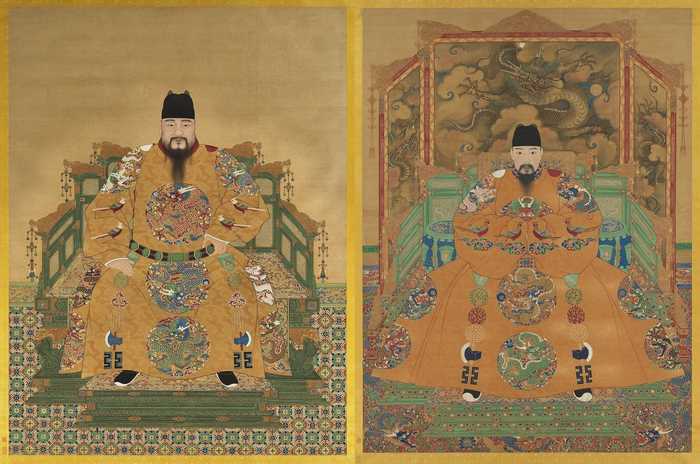
Portraits of the Chenghua (left) and Hongzhi (right) Emperors
In 1464, Emperor Yingzong passed away, and his son ascended to the throne as the Chenghua Emperor (成化帝). During the early years of Chenghua's reign, he showed a deep understanding of the people's sentiments, actively governed the country, and was considered a wise ruler of the time. During his rule, Ming received tributes from various countries and reclaimed the Hetao region (河套) from Mongol tribes under Wang Yue's (王越) leadership.
However, Chenghua struggled with a stutter and introverted personality, leading to infrequent interactions with courtiers. In later years, he became ineffective in governance, favoring concubine Wan Guifei (万贵妃) and trusting corrupt eunuchs. He also allowed occult practices and corruption to flourish, worsening the political system and causing hardships for the people. His direct appointment of officials led to widespread corruption until the reforms of the Hongzhi Emperor (弘治帝).
In 1487, Chenghua passed away, and his son succeeded him as the Hongzhi Emperor. Hongzhi initiated political reforms, eradicating corruption inherited from his father's reign. He dismissed corrupt officials, replacing them with capable individuals, and promoted open discourse while exercising strict control over eunuchs and spy agencies, including the Jinyiwei (锦衣卫, Embroidered Uniform Guard) and Dongchang (东厂, Eastern Depot). His reign, known as the Hongzhi Restoration (弘治中兴), marked a significant period of reform.
In 1505, Hongzhi passed away, and his son became the Zhengde Emperor (正德帝). Zhengde indulged in leisure, handing power to eunuchs known as the "Eight Tigers" (八虎). Despite admonitions from senior officials about the corruption of the "Eight Tigers," they remained in power. Zhengde's lavish lifestyle and neglect of state affairs led to conflicts, including invasions, rebellions, and uprisings. He fell ill during a leisure trip to Jiangsu and died in 1521 at his extravagant palace Bao Fang (豹房, "The Leopards' Chamber").
Reigns of Jiajing and Longqing

Portraits of the Jiajing (left) and Longqing (right) Emperors
The childless Zhengde Emperor was succeeded by the nephew of the Hongzhi Emperor, who became the Jiajing Emperor (嘉靖帝). Upon his ascension, a conflict, known as the Great Rites Controversy (大礼议之争), emerged regarding the declaration of Jiajing's parents as imperial uncles and aunts. Tradition demanded adoption by the preceding emperor, but Jiajing insisted on honoring his own parents as emperor and empress. He prevailed, establishing their status above that of the Zhengde Emperor and dismissing or imprisoning most opponents by imperial decree.
In the early years of Jiajing's reign, he implemented his own political agenda, eliminating longstanding issues, known as the Jiajing Restoration (嘉靖中兴). However, he later neglected state affairs, focusing on superstition and rituals. In 1542, a palace plot by 16 palace maids to strangle him failed, known as the Palace Plot of Renyin Year (壬寅宫变), prompting Jiajing to distance himself from the inner court. He favored Minister Yan Song (严嵩), whose 14-year tenure was marked by purges and favoritism, aided by his son Yan Shifan (严世蕃). Despite accusations of corruption, they remained in power.
During Jiajing's rule, the country faced external threats. The northern Tatars (鞑靼) took advantage of the Ming's weakness to control the Hetao region, while coastal areas in the southeast were plagued by Wokou (倭寇, Japanese pirates).
In 1566, Jiajing passed away, and his son became the Longqing Emperor (隆庆帝). Longqing implemented reforms to rectify governance and initiated policies aimed at improving people's lives and stabilizing the country, known as the New Governance of Longqing (隆庆新政). However, he became disengaged from governance in later years, focusing on leisure activities. In 1572, Longqing died suddenly from a stroke, and his nine-year-old son became the Wanli Emperor (万历帝).
Decline and Fall
Wanli's Reign
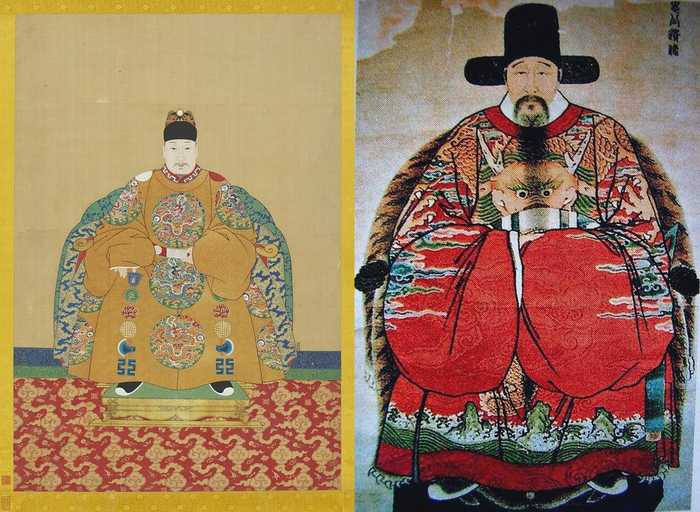
Portraits of the Wanli Emperor (left) and Senior Grand Secretary Zhang Juzheng (right)
As the Wanli Emperor ascended the throne at a young age, his grandmother acted as regent. Zhang Juzheng (张居正), with support from the eunuch Feng Bao (冯保) who enjoyed the trust of the regent, initiated reforms. Zhang introduced the Kaocheng Law (考成法) to assess officials' performance. He also cleared land tax arrears, conducting a nationwide land ownership survey. In 1581, he established a unified taxation system, consolidating various levies into a single silver tax. Zhang also appointed renowned generals like Li Chengliang (李成梁) and Qi Jiguang (戚继光) to safeguard the northern border, ensuring stability.
Zhang Juzheng's assertive actions in the Ming imperial cabinet raised objections from his opponents, who viewed them as exceeding his authority. Despite Confucian norms requiring him to observe mourning and leave his post after his father's death in 1577, Zhang refused, citing unfinished reforms. This defiance was exploited by his political adversaries, tarnishing his reputation. Although he received support from the Wanli Emperor and was exempted from mourning duties, his standing suffered. Zhang's death in 1582 and the subsequent purge of his ally Feng Bao led to further accusations and a rollback of his reforms.

Left: Ming China in the 1580s and its neighbors.
Right: the late Ming market, production areas, and trade directions denoted.
The Wanli Emperor took over governance after Zhang's death, initially showing keen interest. His reign witnessed significant events including the Succession Dispute (国本之争) and Donglin Movement (东林党争), along with military engagements like the Korean Campaign (朝鲜之役) and the Battle of Sarhū (萨尔浒之战). The Wanli era marked a turning point for the Ming Dynasty from prosperity to decline.
The Succession Dispute centered around Wanli's eldest son, Zhu Changluo (朱常洛) who was born to a palace maid, and the third son, Zhu Changxun (朱常洵) who was born to Wanli's favored concubine Zheng Guifei (郑贵妃). The Wanli Emperor favored his third son. Despite pressure from the Empress Dowager, Wanli delayed naming his eldest son, Zhu Changluo, as crown prince until 1601.
The Wanli Emperor harbored extreme dissatisfaction with his ministers over the Succession Dispute, and from 1587 onwards, he began skipping court sessions as a form of retaliation, dealing only with critical matters. After 1588, he was often absent from morning audiences, spending his days in seclusion within the palace.
The Wanli Emperor was also a greedy ruler who, along with the royal family, seized land and exploited the populace under the pretext of logging, manufacturing, and trade. He used eunuchs as tax collectors for mining, triggering protests. He also abolished Zhang Juzheng's Kaocheng Law, leading to a situation where the emperor indulged in extravagance, officials engaged in corruption, and intense factionalism prevailed.
The Donglin Movement originated from the Donglin Academy (东林书院) founded by Gu Xiancheng (顾宪成). The Donglin Movement arose due to a vacancy in the imperial cabinet, with Gu Xiancheng advocating for the inclusion of the accomplished Huaiyang governor (淮扬巡抚), Li Sancai (李三才). However, forces opposing Li's appointment smeared his reputation, leading to the rise of the Donglin Faction (东林党), which became a target of attack by other factions in the court. With the eunuchs gaining more power, the Donglin Faction suffered severe setbacks, only to be revived during the Chongzhen (崇祯) era.
The Wanli Emperor's indifference to governance led to a severe shortage of officials and bureaucratic infighting, paralyzing the government. Factional struggles primarily centered on personnel rather than governance improvements. In the northeast, corruption-plagued Liaodong General Li Chengliang (李成梁), who was trusted by the emperor. He falsified military reports, manipulated military achievements, and favored the Nurhaci (努尔哈赤) forces, exacerbating Ming's border troubles and ultimately facilitating the rise of the Qing Dynasty (清朝).
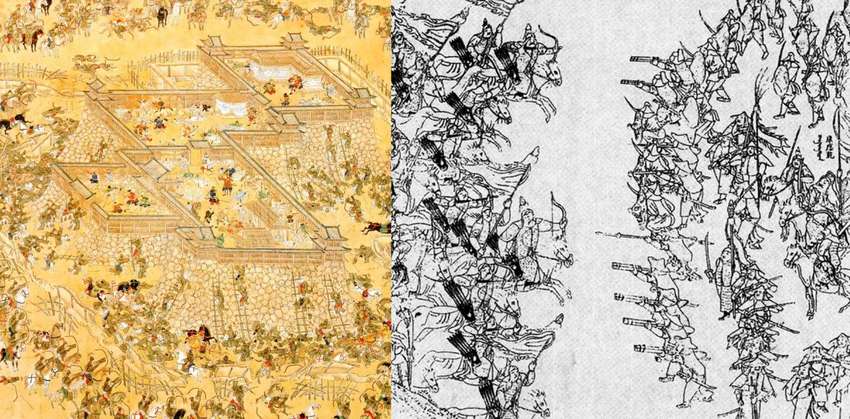
Left: the Korean-Chinese army besieges the Japanese in their fortress of Ulsan (1598).
Right: an illustration of Nurhaci's biography depicting the battle of Sarhu (1619).
In terms of military affairs, the Wanli era was highlighted by the three major expeditions, which successfully secured Ming's borders and defended the Korean Kingdom against Japan but depleted the Ming treasury. In 1617, Nurhaci's rebellion against the Ming, citing the Seven Grievances (七大恨) culminated in the decisive Battle of Sarhū (萨尔浒之战) two years later. From then on, the Ming Dynasty adopted strategic defense against Later Jin (后金).
Control of Eunuchs
In 1620, after the Wanli Emperor's death, his son Zhu Changluo took the throne as the Taichang Emperor (泰昌帝). However, he inherited a troubled empire marked by corruption, economic decline, palace intrigues, weakening military, and border threats from the rising Later Jin. Taichang's short reign saw internal conflicts escalate, leading to his sudden death after just a month on the throne, known as the Red Pill Case (红丸案). His successor, the Tianqi Emperor (天启帝), faced further challenges from palace conspiracies and factional struggles.
During the Tianqi Emperor's early reign, the Donglin Faction's influence surged, fueling internal conflicts. This led Tianqi to allow Wei Zhongxian's (魏忠贤) opportunistic political intervention, resulting in the formation of the Eunuch Faction (阉党). Frequent peasant uprisings and military mutinies nationwide also emerged around the time.
Following 1624, the Eunuch Faction gained control, with Wei Zhongxian wielding immense power, cracking down on Donglin Faction members with fabricated charges. This persecution triggered further rebellions. The emperor's edict in 1625 to burn down academies escalated tensions, with many Donglin Faction members imprisoned or executed, worsening the turmoil of Tianqi's reign and exacerbating both domestic and foreign challenges.
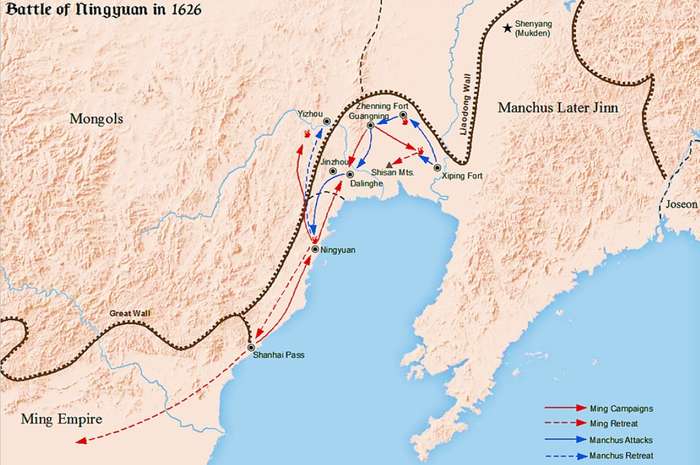
Battle of Ningyuan between Ming and Manchus in 1626
At the time, the Ming Dynasty was facing internal conflicts exacerbated by Later Jin aggression in Liaodong. Competent strategists were dismissed, weakening defenses and leading to Later Jin advances. The Eunuch Faction's influence resulted in executions and dismissals of loyal officials. Despite significant casualties from the Wanggong Armory Explosion (王恭厂大爆炸) in 1626, Ming forces, led by Yuan Chonghuan (袁崇焕), achieved a decisive victory against Later Jin forces at Ningyuan (宁远). However, the Tainqi Emperor's indulgent lifestyle and neglect of governance contributed to Ming's turmoil. He died young in 1627, leaving the dynasty in disarray.
The Chongzhen Emperor and the Fall of Ming
In 1627, Zhu Yujian took the throne as the Chongzhen Emperor (崇祯帝), inheriting a troubled political situation. Diligently attending lectures on classic texts and consulting with courtiers for governance strategies, he actively engaged in state affairs trying to reverse the situation. He also initiated reforms by removing the Eunuch Faction and rectifying wrongful convictions. Despite his efforts and earnest desire for reform, deep-rooted issues of the empire made it impossible to fundamentally change the situation in the short term. His authoritarian tendencies, suspicious nature, and impatience led to further mismanagement, worsening the situation. Dissatisfied with court officials, he turned to another group of eunuchs, granting them significant power, and expanding their influence. These moves intensified conflicts within the ruling elite, hindering substantial progress in governance.

Portraits of the Chongzhen Emperor (left) and Hong Taiji (right)
In 1629, Hong Taiji (皇太极) diverted Qing forces to attack Beijing, leading to the Jisi Incident (己巳之变) where Yuan Chonghuan was executed as a result of Qing's successful use of misinformation. Liaodong's defenses were nearly collapsed. Feeling hopeless and seeking divine intervention, the Chongzhen Emperor briefly explored Christianity after being disappointed with traditional beliefs.
In 1636, Hong Taiji declared himself emperor in Shengjing (盛京, present-day Shenyang, 沈阳), establishing the Qing Dynasty (清朝). He launched multiple invasions into Ming territories, known as the Qing's Southern Expeditions. Over the years, Ming forces clashed with the Qing, culminating in the decisive Battle of Song-Jin (松锦之战) in 1641, leading to Ming's retreat to Shanhai Pass (山海关).
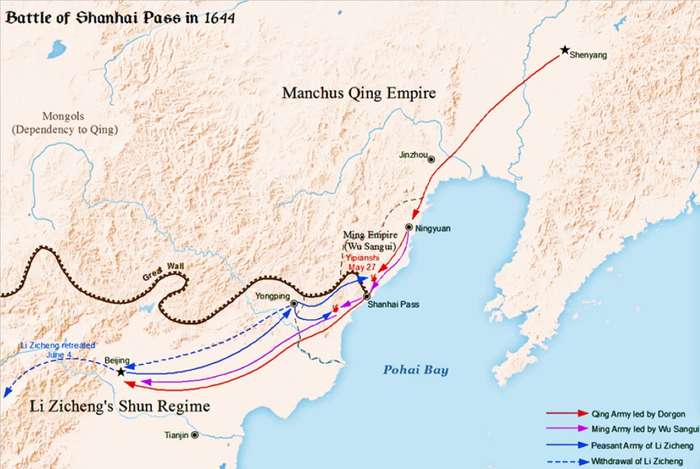
The battle at Shanhai Pass that allowed Manchus to enter China proper in 1644
During Chongzhen's reign, a series of natural disasters struck, including cold snaps, droughts, famines, locust plagues, earthquakes, and bubonic plague. From 1627 to 1641, a 14-year severe drought hit the Yellow River basin, spreading north of the Yangtze River. In 1640, 123 counties experienced cases of cannibalism, marking the most severe famine in nearly 500 years. These disasters, coupled with chaotic governance, corruption, and wars with the Later Jin and Qing invasions, led to widespread peasant uprisings. Eventually, Li Zicheng (李自成) established the Shun Dynasty (大顺) in 1644 and captured Beijing. The Chongzhen Emperor committed suicide in Meishan (煤山), marking the downfall of the Ming Dynasty.
After the fall of the Ming, various regional regimes were established by members of the Ming imperial family. The main powers included the Hongguang Emperor (弘光帝), Regent Zhu Yihai (朱以海), the Longwu Emperor (隆武帝), the Shaowu Emperor (绍武帝), and the Yongli Emperor (永历帝). This period is known as the Southern Ming (南明). On January 22, 1662, the Yongli Emperor was captured, marking the end of the last regime of the Southern Ming.